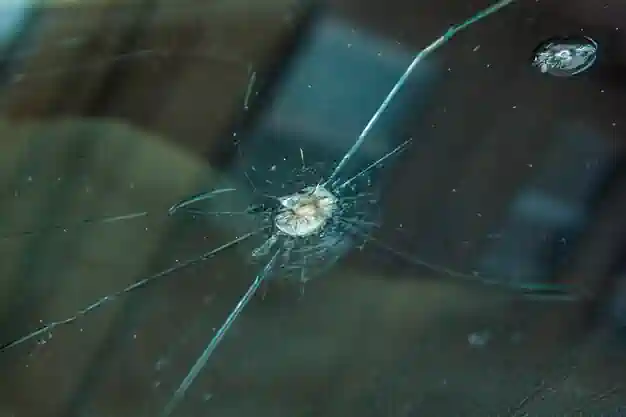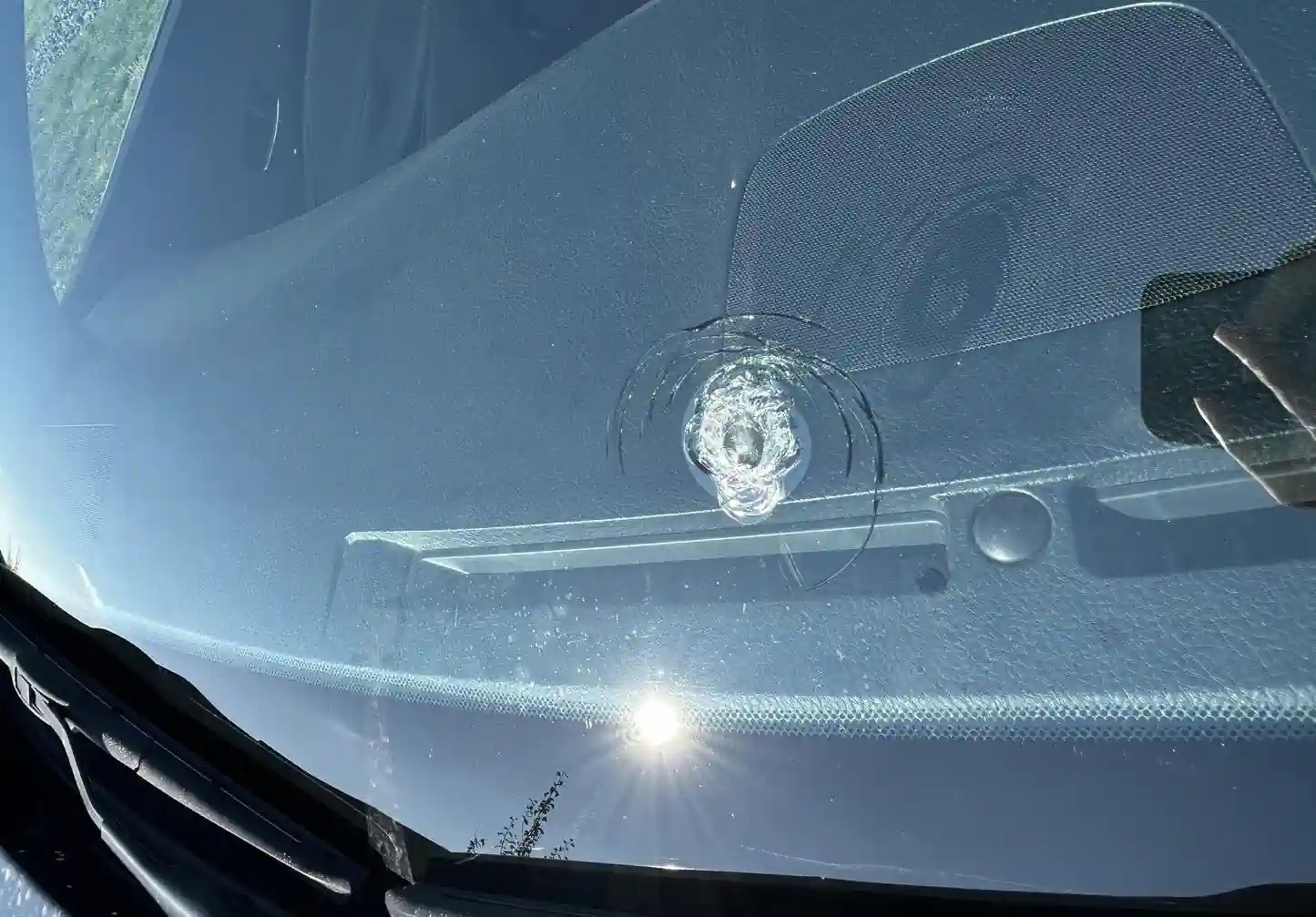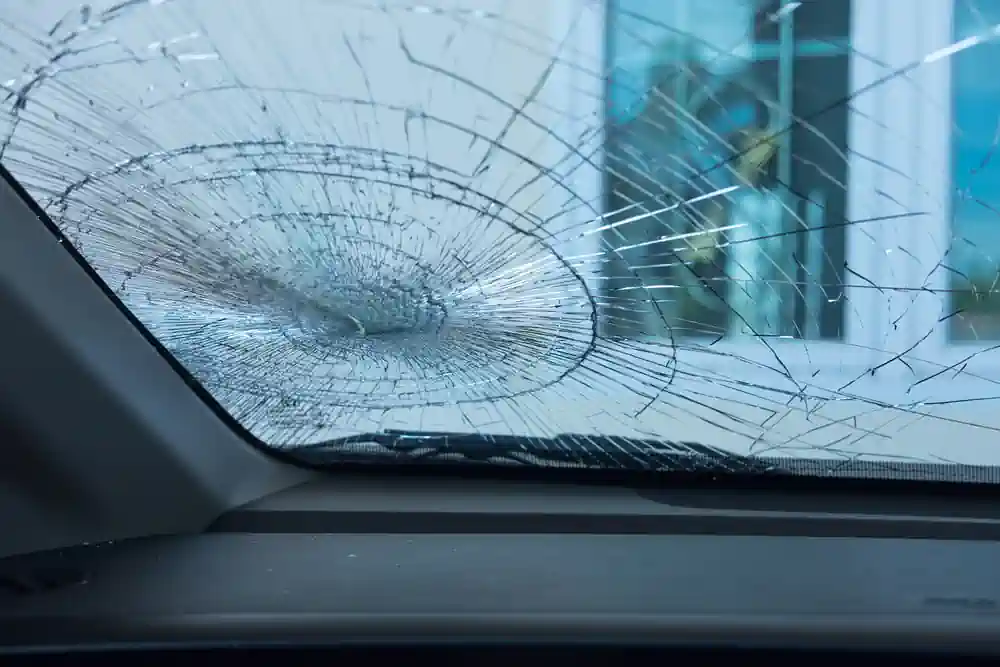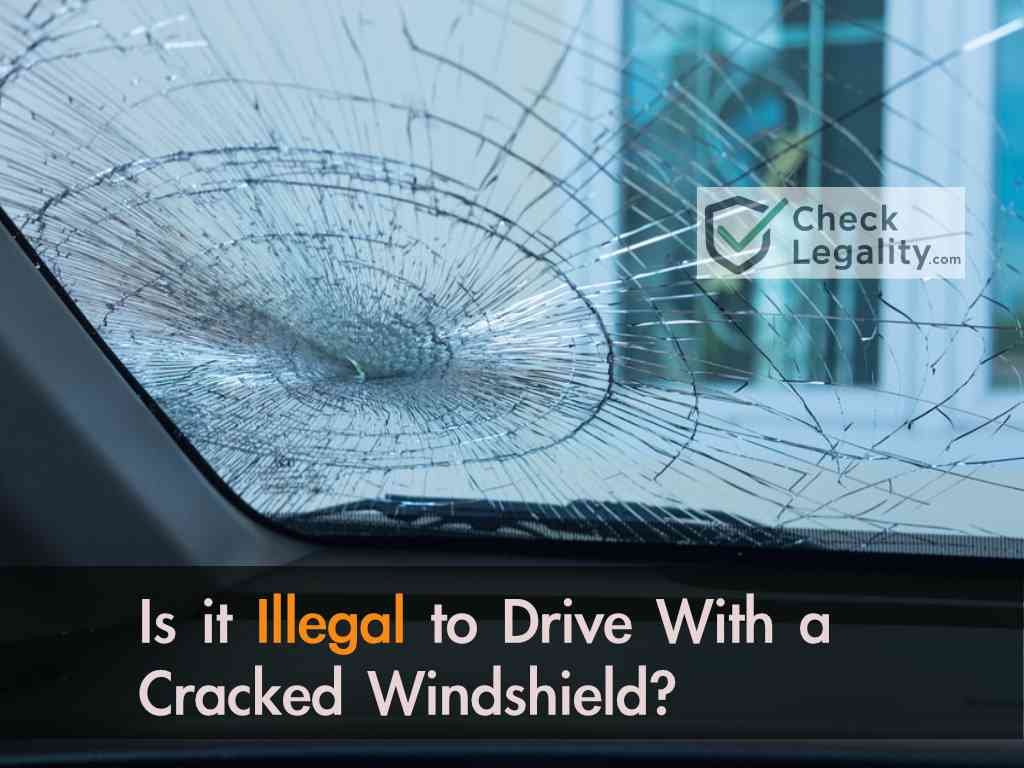To check the legality of the question: Is it Illegal to Drive With a Cracked Windshield? One must understand the differences in sizes and locations when it comes to cracked windshields. Let’s find out more.
I’ve been in that situation. You’re cruising down the highway, enjoying the scenery, when a rogue pebble pings off a truck, leaving a nasty crack snaking across your windshield. It’s a moment of frustration, but a question quickly pops into your head: Is it safe?”Is it illegal to drive with a cracked windshield?”
Is it Illegal to Drive With a Cracked Windshield?
Windshields are more than just a clear panel offering scenic views. They’re a crucial safety component, providing a clear view of the road and acting as a vital barrier in case of accidents. Yet, the legalities surrounding cracked windshields can be surprisingly unclear. This article will comprehensively examine the laws, risks, and repair options associated with driving with a cracked windshield.
Let’s delve into the world of windshield regulations and understand how they vary around the globe.
Is it Illegal to Drive With a Cracked Windshield? – A Global Insight
Unlike traffic regulations for speeding or using turn signals, there’s no universal law governing cracked windshields. Countries and regions have their own set of rules, leading to various unclear regulations around the world.
Here, we’ll focus on three major regions with distinct approaches to windshield crack regulations: North America, Europe, and Australia.
A. Is it Illegal to Drive With a Cracked Windshield In North America:
In North America, windshield crack laws are determined at the state or provincial level, resulting in a diverse legal landscape. There’s no single standard, and the consequences of driving with a cracked windshield can vary significantly depending on your location.
- Legalities: Most states in the US and provinces in Canada have laws prohibiting driving with a windshield that impairs the driver’s vision. These laws often reference specific visibility standards or the size and location of the crack.
- Levels of Illegality: The severity of the offense typically depends on the severity of the crack. Minor cracks outside the driver’s direct line of sight may result in a warning or a citation with a small fine. Larger cracks, spiderwebs, or cracks obstructing vision can lead to hefty fines, penalty points on your driver’s license, and even vehicle defect notices requiring repair before further operation.
- Regional Variations: Some states, like California, have stricter regulations that define acceptable crack size and location. Others, like Texas, offer more leeway as long as the crack doesn’t impede safe driving. It’s crucial to check your state’s or province’s specific laws to understand the potential repercussions.
B. Is it Illegal to Drive With a Cracked Windshield In Europe
Europe generally takes a more unified approach to windshield regulations. The European Union (EU) has directives that member states must follow, ensuring a more consistent level of enforcement across the continent.
- Legality Check: EU directives focus on overall vehicle safety and require windshields to meet specific strength and visibility standards. These regulations indirectly address cracked windshields by ensuring the windshield maintains structural integrity and doesn’t obstruct the driver’s vision.
- Levels of Illegality: Similar to North America, the severity of the offense depends on the crack’s impact on driver visibility. Minor cracks may go unnoticed, while larger ones can lead to fines or even vehicle immobilization if deemed a serious safety risk.
- Regional Variations: While the EU sets the overall regulations, individual member states can implement stricter regulations. For example, Germany may have a lower tolerance for cracked windshields compared to France. It’s always advisable to check the specific regulations in your country.
C. Is it Illegal to Drive With a Cracked Windshield In Australia
Australia, like the EU, emphasizes overall vehicle safety standards. National regulations define acceptable levels of windshield damage based on its impact on driver visibility and structural integrity.
- Legal Framework: Australian regulations focus on the windshield’s ability to provide clear vision and withstand impacts. Cracks that significantly distort vision or compromise the windshield’s strength can be grounds for fines and vehicle defect notices.
- Levels of Illegality: Similar to other regions, the severity of the offense depends on the crack’s size, location, and impact on visibility. Minor cracks may be overlooked, while larger ones can lead to fines and require repair before further driving.
- Regional Variations: While national regulations exist, individual states and territories within Australia may have additional guidelines. Checking the specific laws in your area ensures you’re compliant.
It’s essential to remember that these overviews are just general guidelines. Specific details can differ within each region and, in some cases, depending on the authority personnel you encounter.
The Risks of Driving with a Cracked Windshield
While the legalities of driving with a cracked windshield vary, the safety risks associated with it are universal. A seemingly minor crack can pose a significant threat to you, your passengers, and others on the road.
Let’s delve into the dangers of driving with a compromised windshield:
A. Driving With A Small Crack

Even a small crack could potentially distort your vision, creating halos around lights, blurring road signs, and causing blind spots. This impaired vision is particularly dangerous:
- Night Driving: At night, the already-reduced visibility is compounded by the crack’s light refraction, making it difficult to see pedestrians, oncoming traffic, and potential hazards.
- Bad Weather: Rain, snow, and fog further reduce visibility, and a crack can exacerbate the problem, making it challenging to navigate safely.
- Quick Reactions: In critical situations requiring fast reflexes, a crack can hinder your ability to see and react promptly, thereby increasing the risk of accidents.
B. Compromised Structural Integrity: A Broken Shield

Modern windshields are made of laminated glass, designed to shatter into blunt pieces in case of accidents. However, a crack weakens this structure:
- Reduced Protection: A cracked windshield is less effective in absorbing impact during a collision. This can lead to the windshield shattering completely, potentially causing injuries from flying glass shards.
- Rollover Accidents: Windshields are crucial in maintaining roof integrity during rollovers. A cracked windshield may not offer the same level of protection, increasing the risk of occupant injuries.
- Deployment of Airbags: Windshields are designed to work in conjunction with airbags. A cracked windshield may not provide a proper surface for airbag deployment, potentially leading to malfunction or reduced effectiveness.
C. Driving With Spiderweb Cracked Windshield

A small crack might seem insignificant, but it’s a ticking time bomb waiting to explode:
- Temperature Fluctuations: Extreme temperature changes, from scorching heat to freezing cold, can cause a crack to expand rapidly, potentially shattering the entire windshield.
- Bumps and Vibrations: Driving on rough roads or encountering bumps can exert pressure and stress on the cracked area, increasing the risk of further breakage.
- Minor Impacts: Even a seemingly minor impact, like a stray pebble or a piece of debris, can be enough to send a crack spiderwebbing across your entire windshield, obstructing your vision entirely.
D. Is it Illegal to Drive With a Cracked Windshield After an Accident?
Driving with a cracked windshield can have legal consequences beyond potential fines:
- Negligence Claims: In case of an accident, a cracked windshield can be used as evidence of driver negligence. This can make it more difficult to claim insurance coverage and lead to increased liability.
- Increased Insurance Costs: Having a history of driving with a cracked windshield may raise your insurance premiums as insurance companies perceive you as a higher risk.
These are just some of the significant risks associated with driving with a cracked windshield. While the legalities may vary, the safety implications are clear – a cracked windshield is a hazard waiting to happen. In the next section, we’ll explore the options available to repair or replace your cracked windshield and ensure safe driving.
Repairing or Replacing: Taking Care of Your Cracked Windshield
Now that you understand the legal and safety concerns surrounding cracked windshields, it’s time to explore the solutions. There are two main options: either a partial repair or a full replacement. The best choice depends on the severity of the crack:
A. Windshield Repair vs. Replacement Checks: Making the Right Call
Here’s a breakdown to help you decide:
- Minor Cracks: Small cracks, typically less than a quarter inch in diameter and outside the driver’s direct line of sight, are often repairable. Professional windshield repair technicians can inject a special resin into the crack, filling it and restoring its clarity. This is a cost-effective and quick solution for minor damage.
- Larger Cracks: Cracks exceeding a half-inch in diameter, located within the driver’s direct line of sight, or with multiple branching cracks are generally not repairable. These compromise the windshield’s structural integrity and require a complete replacement for optimal safety.
- Deep Cracks: If the crack penetrates beyond the outer layer of glass and reaches the inner plastic layer, it’s a clear sign for replacement. Windshield repairs typically address cracks on the outer layer only.
- Chips and Bullseyes: Small chips and bullseyes (circular cracks) can potentially be repaired if they’re smaller than a nickel and haven’t developed cracks. Consult a professional to assess the extent of the damage and determine the best course of action.
B. How to Repair A Cracked Windshield
If your crack qualifies for repair, here’s what to expect:
- Cleaning the Area: The technician thoroughly cleans the damaged area to remove any dirt or debris that might hinder the repair process.
- Resin Injection: A special resin is carefully injected into the crack using a vacuum process to remove air bubbles and ensure complete filling.
- Curing the Resin: The resin is cured using ultraviolet light, restoring the crack’s clarity and structural integrity.
- Polishing the Area: The technician polishes the repaired area to minimize any remaining surface imperfections.
Windshield repairs are typically a same-day process and can be significantly cheaper than a complete replacement.
C. Replacing Your Cracked Windshield
If your windshield requires replacement, here’s a general overview of the process:
- Removal of the Old Windshield: The technician carefully removes the old windshield using specialized tools, ensuring minimal damage to surrounding trim and paint.
- Windshield Preparation: The area around the windshield frame is prepped for the new windshield installation.
- Adhesive Application: A special adhesive is applied to the windshield frame to create a strong bond with the new windshield.
- Windshield Installation: The new windshield is carefully positioned and secured in the frame.
- Curing Time: The adhesive needs time to cure completely, usually requiring the vehicle to sit for several hours before driving.
Windshield replacement is a more involved process than repair but is crucial for ensuring optimal safety and structural integrity.
D. Cost Considerations: Budgeting for a Clear View
The cost of repairing or replacing a windshield depends on several factors:
- Severity of Damage: Minor repairs are typically cheaper than extensive replacements.
- Windshield Size and Type: Larger windshields and those with advanced features like rain sensors or heated elements cost more to replace.
- Labor Rates: Labor costs can vary depending on your location and the chosen repair shop.
While windshield repairs can be relatively inexpensive, replacements can be more costly. However, the cost of neglecting a cracked windshield can be far greater in terms of potential accidents, injuries, and insurance issues.
In the final section, we’ll wrap up the key points and emphasize the importance of maintaining a clear and structurally sound windshield for safe driving.
Conclusion: Is it Illegal to Drive With a Cracked Windshield?
We’ve explored the legal complexities, safety risks, and repair options associated with cracked windshields, and the answer is clear: the overall safety concerns from a cracked windshield supersede the legality of driving with one.
Since we have answered the question: Is it Illegal to Drive With a Cracked Windshield? Let’s solidify the importance of prioritizing a clear and structurally sound windshield for optimal driving safety.
Recap:
- The legality of driving with a cracked windshield varies by region. While some places may allow minor cracks, others have stricter regulations. Regardless of the legalities, the safety risks are universal.
- Cracked windshields can significantly obstruct vision, especially at night or in bad weather. This impaired vision can lead to accidents and injuries.
- A cracked windshield weakens the overall structural integrity of your vehicle, potentially compromising protection in case of collisions or rollovers.
- Minor cracks can quickly expand due to temperature changes, bumps, or minor impacts, leading to complete shattering and further safety hazards.
- Driving with a cracked windshield can have legal repercussions after an accident. It can be used as evidence of negligence and increase insurance costs.
- Windshield repairs are a viable option for minor cracks, offering a cost-effective and quick solution. Replacement becomes necessary for larger cracks or those compromising structural integrity.
Importance of Safe Windshields:
Your windshield is not just a large window; it’s a critical safety component of your vehicle. Maintaining a clear and undamaged windshield is essential for:
- Ensuring clear and unobstructed vision for safe driving in all conditions.
- Maintaining the structural integrity of your vehicle in case of accidents.
- Optimal deployment of airbags and other safety features in the event of a collision.
- Avoiding potential legal issues and increased insurance costs.
Recommendations:
Don’t wait for a minor crack to become a major safety concern. Schedule a prompt inspection if you notice any damage to your windshield. Professional repair technicians can assess the crack and advise you on the best course of action, whether it’s repair or replacement.
Investing in a clear and structurally sound windshield is an investment in your safety and the safety of those on the road with you. Prioritize maintaining a clear view and ensure a smooth, safe driving experience for everyone.


